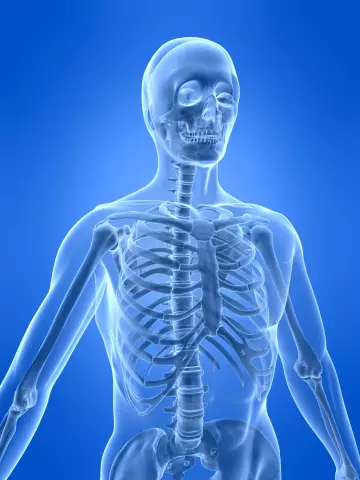- Author Curtis Blomfield [email protected].
- Public 2023-12-16 20:44.
- Last modified 2025-01-23 17:01.
Cats are one of the most popular types of pets in the world. Since the time of the Ancient World, they have enjoyed special respect among people and are surrounded by a real halo of mystery. Evidence of this is the fact that scientists have discovered evidence of their special relationship with humans. A burial site dating back to the eighth century BC was discovered on the island of Cyprus. In this grave, next to the human remains, was the skeleton of a cat.

But few people know what lies behind these beautiful fluffy muzzles. To better understand what allows this creature to have such phenomenal abilities, you need to consider the structure of its body. Such extraordinary maneuverability and grace is provided by the skeleton of a cat. In their physical abilities, cats are superior to most animals. They have a lot of tricks in their arsenal. They can climb trees, jump high, crawl silently, have excellent balance, high sprint speed and lightning-fast reactions.

The skeleton of a cat includes 230 bones, which is 24 units more than a person has. This beast has the shortest skull of all domestic animal species. The composition of the mammalian spineincludes 7 cervical and 13 thoracic vertebrae. Thirteen pairs of ribs are attached to this spine. They form the chest. The cat has 7 lumbar, 3 sacral and approximately 26 caudal vertebrae. The number of the latter may vary, depending on the length of the tail.
The central nervous system of the animal has a reliable protection, due to the fact that the cat has a very flexible skeleton of the spine. A feature of the sternum is that it is connected only to the first nine pairs of ribs. Four more pairs forming an arc are free.
Unlike all other pets, the skeleton of a cat does not have clavicles, so the chest of this animal is connected to the bones of the forelimbs with the help of muscles and special tissue. This feature of the body allows them to squeeze into the narrowest passages into which only the head can fit. This also explains the soft cushioned landing of the beast when jumping.

The forelimb girdle consists of the scapula, ulna, humerus, and radius, plus paw and carpal bones. In the pelvic girdle are the pelvis, femurs, lower leg, kneecaps, heel bones and metatarsus with phalanges of the fingers. The elements of the pelvic limb are more developed than the parts of the chest. This determines the characteristic "jumping" movement of the animal. These beasts conquer heights 5 times their own height.
The joints in cats are divided into three groups: sutures, cartilage and synovial. The first are formed between the fused bones of the skull. They are formed by hard fibers, and they are motionless. The second consists of their solid cartilage. Thanks to them, the cat has its outstanding flexibility. The third type connects the bones together. The mobility of the animal depends on them.
So that you can see the cat's skeleton, the pictures are presented in the article.






